
The Taiwan Strait is a 180-kilometer -wide strait separating the island of Taiwan and continental Asia. The strait is part of the South China Sea and connects to the East China Sea to the north. The narrowest part is 130 km wide.

The People's Liberation Army Air Force, also referred to as the Chinese Air Force (中国空军) or the People's Air Force (人民空军), is an aerial service branch of the People's Liberation Army, the regular armed forces of the People's Republic of China. The PLAAF was officially established on 11 November 1949 and it is composed of five branches: aviation, ground-based air defense, radar, Airborne Corps and other support elements.
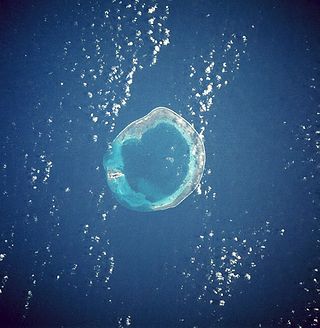
Pratas Island, also known as the Tungsha Islands or the Dongsha Islands, is a coral island situated in the northern part of the South China Sea administered as part of Cijin District, Kaohsiung, Taiwan. It is located about 170 nautical miles southeast of Hong Kong. It has an area of about 240 hectares, including 64 hectares of lagoon, and is the largest of the South China Sea Islands. It is the location of the Dongsha Airport.
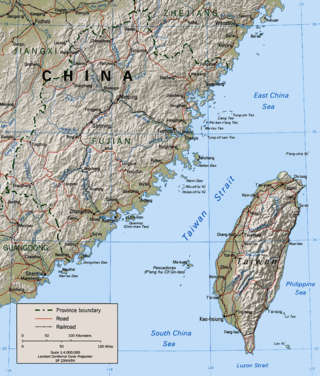
The Second Taiwan Strait Crisis, also called the 1958 Taiwan Strait Crisis, was a conflict that took place between the People's Republic of China (PRC) and the Republic of China (ROC). In this conflict, the PRC shelled the islands of Kinmen (Quemoy) and the Matsu Islands along the east coast of mainland China in an attempt to take control of Taiwan from the Chinese Nationalist Party, also known as the Kuomintang (KMT), and to probe the extent of the United States defense of Taiwan's territory. A naval battle also took place around Dongding Island when the ROC Navy repelled an attempted amphibious landing by the PRC Navy.
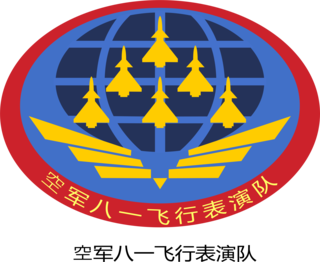
The August 1st or Ba Yi Aerobatics Team is the aerobatic demonstration team of the People's Liberation Army Air Force (PLAAF). It was founded in 1962 and named after the date of founding of the People's Liberation Army (PLA), August 1, 1927.

The Republic of China Air Force (ROCAF), retroactively known by its historical name the Chinese Air Force and unofficially referred to as the Taiwanese Air Force, is the military aviation branch of the Republic of China Armed Forces, currently based in Taiwan. The ROCAF was founded in 1920 by the Kuomintang. While its historical name is sometimes used especially in domestic circles, it is not used as often internationally due to the current ambiguous political status of Taiwan and to avoid confusion with the People's Liberation Army Air Force of the People's Republic of China (PRC).

The People's Liberation Army Naval Air Force is the naval aviation branch of the People's Liberation Army Navy.
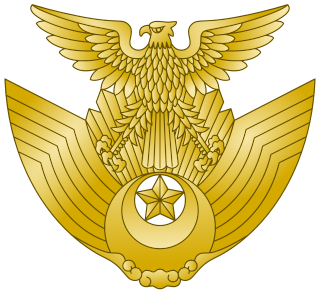
The Japan Air Self-Defense Force, JASDF, also referred to as the Japanese Air Force, is the air and space branch of the Japan Self-Defense Forces, responsible for the defense of Japanese airspace, other air and space operations, cyberwarfare and electronic warfare. The JASDF carries out combat air patrols around Japan, while also maintaining a network of ground and air early-warning radar systems. The branch also has an aerobatic team known as Blue Impulse and has provided air transport in UN peacekeeping missions.

The Xian H-6 is a twin-engine jet bomber of the Chinese People's Liberation Army Air Force (PLAAF). The H-6 is a license-built version of the Soviet Tupolev Tu-16 and remains the primary bomber aircraft of the People's Republic of China.
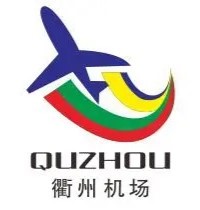
Quzhou Airport, also called Quzhou Air Base is a dual-use military and civil airport located 2.9 kilometers east of the city of Quzhou in Zhejiang Province, China. Originally only a military airfield for the People's Liberation Army Air Force, the airport was first expanded for use by American bombers during World War II, and was later occupied by Japanese troops. A small passenger terminal opened to commercial flights on 26 November 1993, though expanded commercial use of the airport has been hampered by continued heavy military presence due to the airport's proximity to the East China Sea and Taiwan Strait. Airlines operating out of Quzhou Airport generally operate medium to large narrow-body aircraft, such as the Boeing 737. Quzhou's commercial passenger terminal is unique in being separated from the airport's two aircraft bays by a lake, requiring passengers to walk across a lengthy causeway before boarding. The airport serves as the base of operations for regional carrier Quzhou Airlines.
The 1st Fighter Brigade, sometimes called 1st Air Brigade, previously 1st Fighter Division, is a fighter aircraft unit of the Chinese People's Liberation Army Air Force (PLAAF) based at Xianyang in Shaanxi province. Part of the Northern Theater Command Air Force, the brigade was originally established as the first division level formation of the PLAAF, established 19 June 1950. In the Korean War the unit shot down 92 airplanes. It was the first in PLAAF history to fight in air combat, provide close air support, perform night bombing operations and more. It is also the only air brigade of the People's Liberation Army Air Force to participate in five Chinese national day parades. The unit's MUCD is 93056.
An air defense identification zone (ADIZ) is the airspace of a country plus an additional wider area over land and water in which a country tries to identify, locate, and control any civil aircraft in the interest of national security. They are declared unilaterally and may extend beyond a country's territory to give the country more time to respond to possibly hostile aircraft. The concept of an ADIZ is not defined in any international treaty and is not recognized by any international body.

The East China Sea Air Defense Identification Zone is an air defense identification zone covering most of the East China Sea where the People's Republic of China announced that it was introducing new air traffic restrictions in November 2013. The area consists of the airspace from about, and including, the Japanese controlled Senkaku Islands north to South Korean-claimed Socotra Rock. About half of the area overlaps with a Japanese ADIZ, while also overlapping to a small extent with the South Korean and Taiwanese ADIZ. When introduced the Chinese initiative drew criticism as the ADIZ overlapped with the ADIZ of other countries, imposed requirements on both civilian and military aircraft regardless of destination, and included contested maritime areas

The Eastern Theater Command is one of the five theater commands of the People's Liberation Army (PLA), founded 1 February 2016. It replaced the Nanjing Military Region. The command is headquartered in Nanjing.
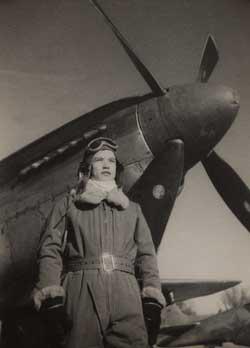
Lin Hu was a Chinese aviator, fighter pilot and lieutenant general of the People's Liberation Army Air Force (PLAAF). Born to a Russian mother and a Chinese father, he was orphaned at a young age. Lin joined the Eighth Route Army to fight in the Second Sino-Japanese War before he turned 11. After the Second World War, he was trained as a fighter pilot and fought in the Korean War and the Second Taiwan Strait Crisis. He served as deputy commander of the PLA Air Force from 1985 to 1994 and attained the rank of lieutenant general in 1988.

The 2022 Chinese military exercises around Taiwan were a series of military exercises by the People's Republic of China (PRC) that encircled Taiwan, officially the Republic of China (ROC). They initially lasted from 4–7 August 2022 and involved live-fire drills, air sorties, naval deployments, and ballistic missile launches by the People's Liberation Army (PLA). The exercises started in response to US Speaker of the House Nancy Pelosi's visit to Taiwan.

The 8th Bomber Division or 8th Air Division of the People's Liberation Army Air Force (PLAAF) is an air formation of the People's Republic of China (PRC). Today, the 8th Bomber Division is assigned to the Southern Theater Command and operates Xian H-6 bombers. The 8th Bomber Division, the first and longest-serving bomber unit in the PRC, has been deployed in the 1950–1953 Korean War, 1958 Second Taiwan Strait Crisis, 1959 Tibetan uprising, and today conducts deterrence patrols in the South China Sea.

The 10th Bomber Division or 10th Air Division of the People's Liberation Army Air Force (PLAAF) is an air formation of the People's Republic of China (PRC). The 10th Bomber Division has been accorded the honorary titles of "Model Bomber Group" (模范轰炸机大队) and "Red Banner Division" (红旗师) and is the PLAAF's unit of choice to send to international skills competitions.

The 66th Brigade, also known as the 66th OPFOR Brigade or 66th Blue Brigade is an air formation of the People's Republic of China (PRC). The 66th Brigade serves as an aggressor unit designed to simulate adversarial air combat forces in training. Appearing to be the only such opposing force (OPFOR) unit of the Chinese People's Liberation Army Air Force (PLAAF), the unit can be compared to the aggressor squadrons of the United States and Canada. The unit is garrisoned at Cangxian Air Base in Hebei Province and reports to the Air Force Flight Test and Evaluation Center, itself subordinate to the Air Force Flight Test and Training Base (FTTB).
The 8th Fighter Brigade is a fighter aircraft unit of the People's Liberation Army Air Force. Previously the 8th Fighter Regiment of the 3rd Air Division, the unit serves as part of the Eastern Theater Command Air Force, responsible for conflict in the East China Sea and Taiwan Strait.

















